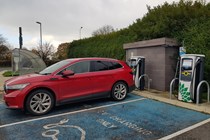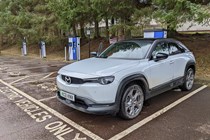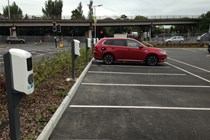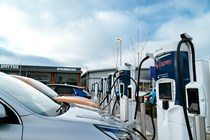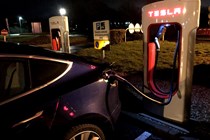The market for new – and used – electric cars (EVs) in the UK may be rather volatile at the moment, but the public EV charging infrastructure to support them is growing. The cost of using public chargers has stabilised after a period of volatility, as well, however prices remain relatively high. As a result, £10 of charge often takes you less far than the same amount of petrol or diesel.
Here, we’re going to take stock of the current public EV charging situation. We’ll look at how many chargers there are in the UK, where they are and what they cost to use. Most of the data presented here is taken from charger mapping service Zapmap’s latest report, published in December 2024. Broadly speaking, the picture is improving despite the appetite for EVs waning. 24% of Parkers readers in the market for a new car are currently considering electric – a drop of 2% from 2023. Add in used cars, and the figure drops to 17%.
How many EV chargers are there in the UK?
As of the end of December 2024, there are 36,316 charging locations with 72,594 EV charging points and 106,094 connectors, according to Zapmap’s report. 1,135 charging points were added in November alone. To clarify the terminology used there, a charging location is analogous to a fuel station, a charging point to a fuel pump and a connector to a fuel pump hose.
There are three types of connector – Type 2, CCS and CHAdeMO. According to Octopus Energy’s charging infrastructure report for Q3 2024, there are more than 70,000 Type 2 connectors available across the UK, plus there are 15,000 CCS and 8,600 CHAdeMO connectors.
Zapmap’s report shows there are 25,361 rapid/ultra-rapid connectors, spread across 5,821 locations. Rapid chargers deliver electricity at a rate of 50-149kW, ultra-rapids at 150kW-plus. Zapmap also notes there are 510 rapid charging hubs across the country, with at least six charging points that operate at 50kW or more. And that’s not counting the 63 hubs only available to Tesla drivers.
Where are the UK’s EV chargers?
Predictably, Greater London has the most charging points of anywhere in the UK – by a big margin. Zapmap calculates there are 21,488 within the capital, compared with 9,290 across the South East. The West Midlands ranks third with 7,156 points and Scotland is fourth with 6,015. Northern Ireland comes last with just 651.
How much does it cost use public EV chargers?
According to Zapmap’s price index for November 2024, the average cost of using a public slow/fast EV charger (49kW or less) is 57p/kWh, and 80p/kWh for a rapid/ultra-rapid (50kW-plus) charger. The former increased by 4% over the preceding 12 months, while the latter didn’t change. For comparison, the domestic energy price cap fell by 7%, and the average off-peak domestic electricity rate dropped by 10%.
Petrol vs public charging prices
The gap between the cost of petrol, diesel and public EV chargers has closed recently to the point that there’s near-parity. Using Parkers’ miles per pound data, we can directly compare fuel and charging costs by showing how far your money will take you. Here, we’ve got some like-for-like comparisons showing how many miles £10 will get you in a petrol car and an equivalent EV. As you can see, the numbers are very close; any significant differences are really down to the two cars’ relative efficiency.
- Audi Q5 45 TFSI vs Q8 e-tron 50 – Petrol takes you 46 miles for £10, whereas electricity from a public charger takes you 43 miles.
- BMW 420i Gran Coupe vs i4 eDrive40 – Petrol takes you 57 miles for £10 as does electricity, showing how similar the two car’s efficiency is.
- Citroen C4 1.2 PureTech 130bhp vs e-C4 – Petrol takes you 69 miles for £10, whereas electricity from a public charger takes you 59 miles.
- Hyundai Tucson 1.6T GDi 48v vs Ioniq 5 63kWh – Petrol takes you 62 miles for £10, whereas electricity from a public charger takes you 63 miles.
- Mercedes-Benz EQB200 vs EQB300 – Petrol takes you 57 miles for £10, whereas electricity from a public charger takes you 52 miles.
- Vauxhall Mokka 1.2 Turbo 136ps vs Vauxhall Mokka Electric – Petrol takes you 75 miles for £10, whereas electricity from a public charger takes you 60 miles.
The most common public electric car chargers rated
Ranked in order of performance experienced by the Parkers team, in this guide we help you understand which operators provide public charge points, how to access them and what prices you can expect to pay. All prices given are per kilowatt hour (kWh) of electricity, unless otherwise stated. Below, you can also understand the types of charging port and differences in power delivery, the science of charging and more on hydrogen development.
1. Tesla
2. Gridserve
3. Pod Point
4. Fastned
5. Instavolt
7. Geniepoint
8. Ionity
10. Osprey
12. Chargeyourcar (CYC)
1. Tesla Supercharger network

There’s no denying Tesla got the jump on providing its customers a reliable network of fast charging points, offering quite simply the best service in the UK. Early Tesla owners were given lifetime free use of the chargers, but Tesla changed the policy after some owners abused it by never charging at home.
In May 2022, Tesla opened up access of its Supercharger network to non-Tesla customers. The pilot was also extended to Spain, France, Belgium, Sweden and Austria. This won’t necessarily come as good news to some Tesla drivers on the continent, however, who have been reporting queues of up to an hour to use a Supercharger. Tesla has introduced off-peak hour discounting to alleviate this situation.
Tesla Superchargers have also become the target of vandalism, with cables being cut in protest against EV uptake.
Size of network: Well over 1,000 chargers at 140 locations in the UK. That includes Superchargers and Destination Chargers that you’ll find at certain hotels, golf clubs, theme parks, and so on.
Tesla Supercharger cost: First 1,000 miles per year are free, then from £0.43 pfor Tesla customers. Non-Tesla customers can sign up for monthly membership of £10.99, which gives them a lower price than that paid by non-members. The average cost for non-members is £0.53.
How to charge: Tesla drivers and newer non-Tesla customers need to use the Tesla app to hook up and pay.
Our experience: Quite simply the best. However, our experience has been a little skewed, since anyone with a Tesla on loan, including prospective customers, can charge using the Supercharger network for free. Ease-of-use is straightforward enough and availability has never been an issue.
2. Gridserve

You might be familiar with the brand Ecotricity that was acquired by Gridserve in June 2021. Gridserve opened its first multi-point EV charging service station, called ‘Electric Forecourt’, at Braintree, Essex in March 2020. The Electric Forecourt provides enough points to charge 24 cars simultaneously and an area for food, drink, shopping and dog walking while vehicles are on charge.
Size of network: Gridserve has over 190 locations with 1,500 charging points. Three electric forecourts are in operation at Braintree, Norwich and Gatwick Airport. Another five are on the cards.
Price to charge: Fast chargers (up to 49kW) cost £0.49, while rapid and ultra-rapid chargers (50kW-plus) cost £0.79. Electric Forecourts charge a flat rate of £0.79.
How to charge: Through Gridserve’s interactive map, you can find chargers on your route. All Gridserve points take contactless payment.
3. Pod Point
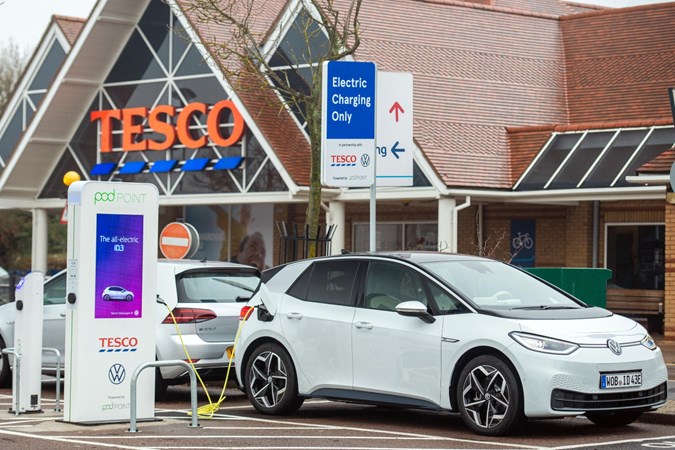
One of the oldest networks in the UK, Pod Point, like others on this list, provides domestic and commercial charge points, as well as operating its own charging network. Some of the commercial chargers are for use in its network, such as those found at Tesco and Lidl.
Size of network: There are over 5,000 locations with over 9,000 charging points. They are more commonly found in Tesco car parks and Pod Point has also introduced so-called EV Zone locations.
Price to charge: Pod Point used to be free at Tesco, but charges have now been introduced. Rates vary depending on how fast the charger is. You’ll pay £0.44 to £0.49 for a fast charger and £0.62 to £0.69 for a rapid charger. An EV Zone costs £0.39 to £0.89, depending on charger speed.
How to charge: Through the app, whether you register or not, you have to find the charge point name and initiate the charge that way.
4. Fastned
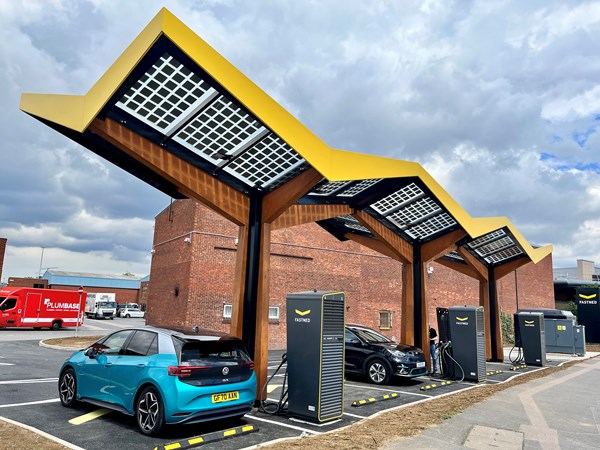
Fastned has some 21 stylish, multi-charge point sites stretching from Scotland to Sandwich and a new ultra-rapid charge station with six bays in Greenwich. The European network, based out of Holland, is quickly adding to its charge point count.
Committed to using 100% renewable energy, the locations with a distinct solar canopy help keep drivers dry, as well as generating some of the energy used to charge. The new Greenwich chargers are capable of charging a compatible EV to 186 miles in 15 minutes.
Size of network: The UK has 21 Fastned locations, most of them in the North East, and the company aims to ultimately create 1,000.
Price to charge: £0.69 – unless you’re a member paying the £9.99 monthly subscription, in which case the price is £0.48.
How to charge: Two methods: be a Gold member for discounts, or Pay-as-you go
Our experience: Fairly positive with Fastned: turn up, plug in, tap your card, charge and go. Once, in a field of five chargers, the first two weren’t working; screens didn’t feature a welcome message and needed to be reset. Fastned customer service was helpful and can initiate remote updates, but still required a phone call. Also, it’s not cheap. Efficient but expensive.
5. InstaVolt
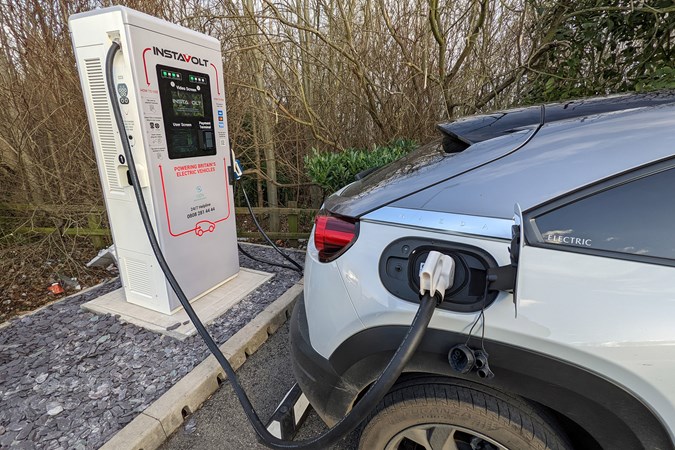
InstaVolt is the UK’s largest owner-operator of rapid DC charging points, meaning it develops, installs, owns and operates all devices on its network. Not only does it have a great reputation for ease-of-use (you simply rock up and pay with contactless or the app, pay-as-you-go) but the chargers always seem to have good availability.
Size of network: InstaVolt currently has over 1,800 chargers in its network. In June 2022 InstaVolt became the second largest rapid charging network in the UK, and plans to install 10,000 rapid EV chargers by 2032.
Price to charge: InstaVolt charges peak and off-peak rates. Peak time is 06:00 to 22:00 when charging costs £0.85. Off-peak time is 22:01 to 05:59 when the cost is £0.54.
How to charge: Pay-as-you go, via contactless cards
Our experience: Largely positive, but not cheap. Our experience of Instavolt has always been good, albeit pricey, with machines being reliable and easy to use.
6. Shell Recharge
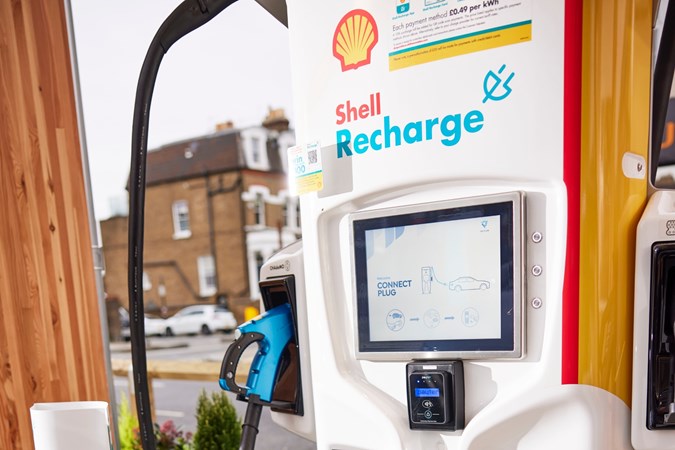
In January 2022, Shell Recharge opened its first all-EV charging hub, with nine charging points, a Costa cafe, Little Waitrose and other provisions in Fulham, London. The city is where 50 of its on-forecourt charging points are already located.
Size of network: In little more than two years, Shell has installed nearly 9,000 chargers at 600 locations. That includes on-street chargers.
Price to charge: Shell charges different rates depending on how you pay – a Shell card or keyfob costs less than a contactless card. At a 7-22kW charger, the lower rate is £0.75 and the higher rate is £0.79. Rapid and ultra-rapid chargers costs £0.81 to £0.89 at the lower rate and £0.85 to £0.93 at the higher rate. On-street chargers card only be used with a Shell card or keyfob and cost £0.51.
How to charge: Via the Shell Recharge app, or Pay-as-you go
Our experience: First impressions say Shell operates one of the more expensive charging tariffs for EV drivers, second to Ionity — but we need more exposure to the Shell Recharge network, so watch this space.
7. GeniePoint
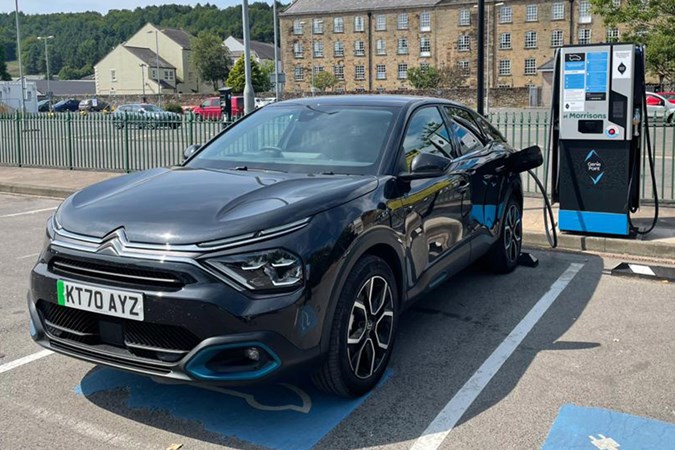
Engie EV solutions runs the GeniePoint network of over 500 locations. More than half of it chargers can be found at Morrisons supermarkets.
Price to charge: Genie Point chargers a flat rate of £0.83. A maximum stay of 90 minutes is allowed; over your welcome and you’ll be charged £10.
How to charge: Register with the app or with a pre-registered access card.
Our experience: Average — one rapid charger we visited, on a forecourt in Great Yarmouth, caused us issues. No contactless payment, no mobile signal. No way of remotely initiating charge from customer services. (To make matters worse, no loo.) Eventually, when the app had confirmed ‘initialising charge’, we wandered off for 20 minutes, only to return to a car that had charged for less than a minute.
Later, Geniepoint called us back and explained the ongoing chip shortage has delayed the rollout of its devices getting the contactless payment updates. Other chargers we’ve used are more reliable, but rarely deliver the promised charge – and are often on sites that are time limited.
8. Ionity
Ionity is the charging network a number of carmakers are backing. If you have a car that supports it, Ionity’s Ultra Rapid Chargers can deliver up to 350kW, which means you’re topping up from 20-80% on compatible EVs in less than 20 minutes.
In October 2022, Ionity announced a collaboration with the e-mobility technology company, &Charge. This platform enables drivers to rate the functionality, repair status and cleanliness of the charging stations and offer extensive feedback. By ‘becoming part of the quality assurance process’, drivers are rewarded with a monetary credit against their charging account.
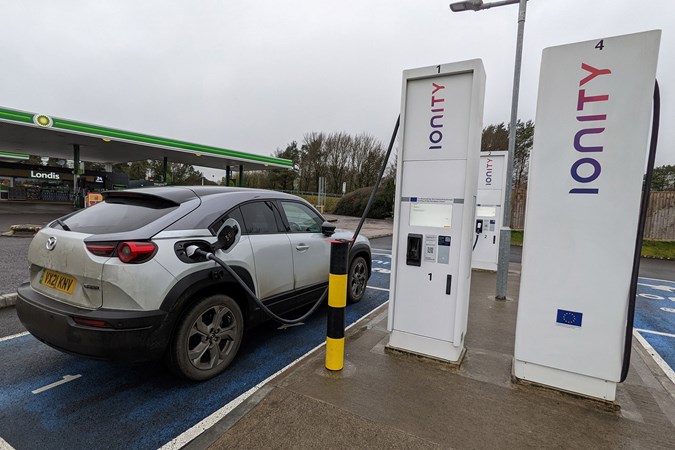
Size of network: 28 locations in the UK, with four or more charge points on each site. 16 more sites were bring built as of May 2024.
Price to charge: Simply turn up at an Ionity charger and you’ll pay a flat rate of £0.74. Pay £5.49 a month for a Ionity Passport Motion plan and the price drops to £0.53. An Ionity Passport Power subscription costs £10.50 a month, dropping the price further to £0.43.
How to charge: Contract or pay-as-you go, via the app
Our experience: Largely positive. Very fast, but expensive, with charger banks in good locations – some failed charges, though. Excellent phone support, too. Some connector issues stop it from being further up the list.
9. Osprey
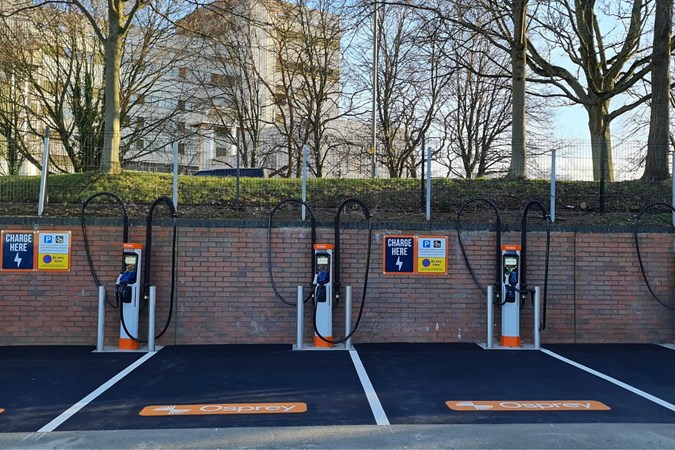
Like Fastned and Gridserve, Osprey is committed to providing a network of rapid-chargers in accessible locations. Those locations include supermarkets, pubs and coffee shops. It’s also keen to ensure ‘accessibility’ is for all, so locations are well-lit and disability-friendly. In August 2022, the brand partnered with British Garden Centres to roll out additional rapid chargers in the car parks of its UK stores.
Size of network: Around 200 sites with 1,000-plus chargepoints, including four high-power charging hubs, with views to secure a further 150 hubs over the next four years. Osprey reckons its ultra-rapid chargers can add 100 miles of range in as little as 20 minutes.
Price to charge: A flat rate of £0.79 is charged, however some older charging points charge a fee of £6.00 per session.
How to charge: Osprey App gives regular users access to monthly billing, receipts, etc.
Our experience: Osprey is also on our list of points to try, so we’ll keep you posted.
10. BP Pulse

BP took over the largest public network, formerly Chargemaster, integrating the Polar Network then rebranded into BP Pulse. It’s been a rocky road. Though no one could doubt its commitment to providing a broad network of accessible, fully working charge points, the reality isn’t as straightforward.
Nonetheless, it is the UK’s biggest network, since it supplies a number of other networks, including Chargeplace Scotland, ChargeyourCar, BMW’s ChargeNow, Islington Council, D2N2 supporting Derby and Nottingham, and Evolve in Jersey. To get access to these chargepoints, however, you still need the corresponding app. BP has yet to amalgamate them into one.
Size of network: 8,750 chargepoints, from pulse7 (7kW delivery) to pulse150 (150kW), the latter being rolled out onto the BP forecourts with over 1,200 nationwide. The newest announcement should see that number more than double by 2030, with a focus on superfast charging points.
Price to charge: Pitch up to a fast charger and you’ll you pay £0.59, rapid chargers cost £0.79 and ultra-rapids are £0.85. Become a member for £7.85 per month and the prices drop to £0.44, £0.63 and £0.69 respectively.
How to charge: Through the BP Pulse app, via contactless or an access card
Our experience: Mixed. The scale of the network means we’re never sure what kind of experience we’re going to have using any given point, and we’re finding an above average number of chargers out of order. That said, if a point isn’t working, BP Pulse open the point up for ‘Free Vend’, meaning this network won’t leave you stranded, and we like the fact that you can pay without an account using contactless. However, guest charging is more expensive, and an account costs £7.85 per month + £9 monthly credit.
New to the scene
EvoEnergy
In partnership with York City Council, EvoEnergy has opened two electric car HyperHubs in York.
The Monks Cross HyperHub, next to one of York’s Park and Ride sites is one of the largest EV charging hubs in Northern England. It features four 175kW ultra-rapid chargers (which can be upgraded to 350kW when more EVs can charge at this rate), four 50kW rapid chargers, with an adjacent area having thirty 7kW chargers for Park and Ride users. Prices are shown on a fuel station-style display board.
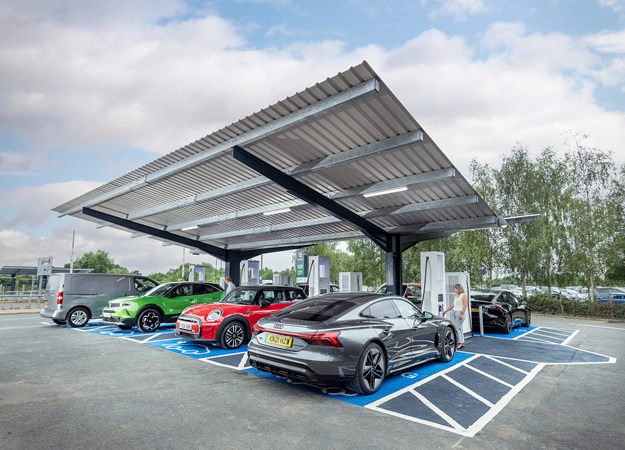
Useful things to know about public electric car chargers
Charging ports
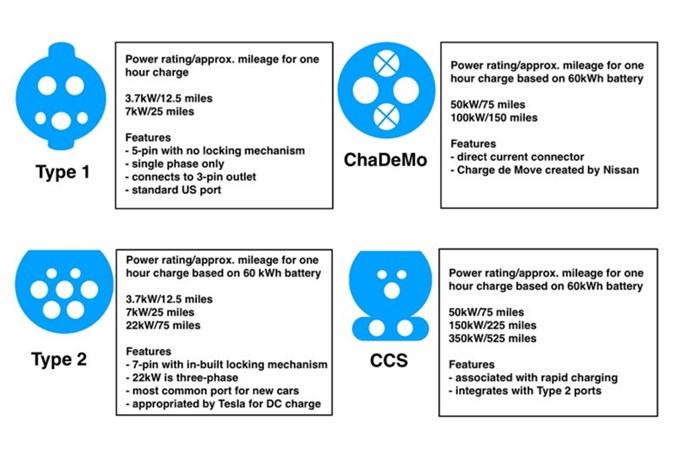
There are a few things you’re going to have to know before you can consider yourself a canny EV driver. The first thing you’ll notice as you become familiar with electric vehicles are the different charging ports. Like Apple’s Lightning cable versus the micro-USB, the port type depends on the manufacturer, country of purchase and how fast the manufacturer wants you to be able to charge. While non-standardisation is frustrating, it’s a legacy result of manufacturers trying to reduce charging times, to make electric vehicles more appealing, thus borne from good intentions.
The charge points are sized in kilowatts, or kW. The most important thing to note is the bigger the number of kW, the larger the possible delivery of power to your car, thus the greater mileage you can recharge in a shorter amount of time.
Locations of charging
There are three core locations: 1) base, 2) en route and 3) at destination.
1. Base
Base charging is essentially charging at home. That said, it doesn’t necessarily mean on your particular driveway. To be inclusive of the 40% of households which don’t have the accessibility of a charge point proximate to their residence, there are alternative solutions, such as on-street charging, community charging networks and portable chargers. Whatever option you use, base charging is where the majority of charging happens.
It’s usually the cheapest way of charging your electric vehicle, since the car’s companion app can enable drivers to schedule a charge. Since, charging only starts when timed to, owners can take advantage of the cheaper overnight tariffs from energy suppliers.
Overnight charging is slower, usually through a 3kW, or more commonly a 7kW charge point.
2. En route
Route charging is most common for EV drivers covering many motorway miles. Driving an EV on a motorway is the quickest way to deplete battery reserves. This is because the road type, unlike undulating country roads or stop-start city streets, doesn’t take advantage of regenerative braking technology. For that, hills are your friend.
Car makers have configured their proprietary navigation systems to do the hard work for you, by suggesting charge points along the road as waypoints to head for. That being said, these navigation systems don’t always show the real-time availability, charge point status or cost, unlike the very comprehensive Zap-Map app.
These charge points tend to be 50kW or 150kW, and rather impressively 350kW charge points are beginning to pop up, albeit cautiously. These could see charge times reduce to as little as 15 minutes for a full charge 0-100%. However, the on-board charger plays a significant role in how quickly your vehicle can charge too.
3. Destination
Destination charging accounts for the charging done away from the home while you’re doing something else.
These points tend to deliver 22kW or 50kW of charging power (though some can be only 7kW). They often come with additional perks, like free parking. They are usually found in locations where dwell-times are higher, such as a shopping centre, the cinema or even rurally located eateries. We’ve found brands such as Tesco, Lidl, Starbucks and Costa are really clued into this model, where Beefeater, Sainsbury’s, Aldi and Premier Inn are some of the many brands that could try harder.

The science of charging
Charging quickly isn’t everything. As helpful as rapid charging is to the course of our day, particularly on a long journey, regularly juicing the battery fast will cause deterioration in the chemical components of the battery itself.
Initially when the charge starts, the energy transfer from source to battery is slow. As charging occurs, the battery cells heat up. At first, the heat aids the battery to charge faster, so the charging rate increases until it hits a sweet spot. However, as the cells get hotter, the charge slows down again to protect them. This is why EV drivers tend to be charging between 20-80% of their battery’s capacity.
Home chargers are usually 3kW or 7kW as these work easily alongside the single-phase set-up already in our homes (though some homes have three-phase and thus, can go to 22kW units if desired). In order to protect the battery, car manufacturers have configured a limit on how quickly the battery can charge at home to prevent battery degradation.
The key brands manufacturing these units are Andersen, BP Pulse, Easee, EO, EVBox, Indra, Ohme, Tesla, Wallbox and Zaptec. Each brand has a different unique selling point, whether you’re looking for a three-phase compliant box, one which locks or one which integrates with pre-existing solar panels, so it’s worth looking into the options best suited for your circumstances. Rightcharge offers a great comparison tool for finding the best home charger for you, while also helping you to compare EV tariffs from energy providers.
Just so you know, we may receive a commission or other compensation from the links on this website - read why you should trust us.




